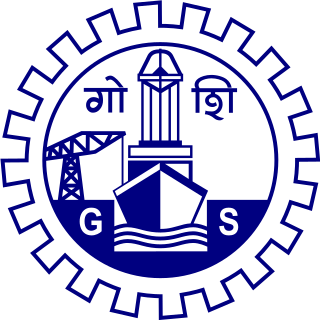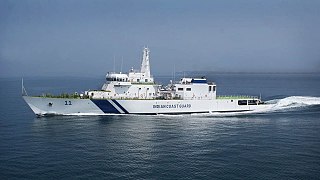
The Indian Coast Guard (ICG) is a maritime law enforcement and search and rescue agency of India with jurisdiction over its territorial waters including its contiguous zone and exclusive economic zone. It was formally established on 1 February 1977 by the Coast Guard Act, 1978 of the Parliament of India. It operates under the Ministry of Defence.

The Talwar-class frigates or Project 11356 are a class of stealth guided missile frigates designed and built by Russia for the Indian Navy. The Talwar-class guided missile frigates are the improved versions of the Krivak III-class frigates used by the Russian Coast Guard. The design has been further developed as the Admiral Grigorovich-class frigate for the Russian Navy. Six ships were built in two batches between 1999 and 2013.

Goa Shipyard Limited (GSL) is an Indian Government owned ship building company located on the West Coast of India at Vasco da Gama, Goa. It was established in 1957, originally by the colonial government of the Portuguese in India as the "Estaleiros Navais de Goa", to build barges to be used in Goa's growing mining industry, which took off after the establishment of India's blockade of Goa in 1955. In the wake of Portugal's defeat and unconditional surrender to India following the 1961 Indian annexation of Goa, it was requisitioned to manufacture warships for the Indian Navy and the Indian Coast Guard.

The Saryu class of offshore patrol vessels (OPV) are advanced patrol ships of the Indian Navy built at the Goa Shipyard Limited. These vessels are capable of ocean surveillance and monitoring and can maintain control of shipping lanes. They can also be deployed to provide security to offshore oil installations, and other naval assets.

ABG Shipyard Limited is a shipbuilding company headquartered in Mumbai, Maharashtra,India.
The Kattupalli Shipyard, officially Adani Katupalli Port Private Limited is a large shipyard project at Kattupalli village near Ennore in Chennai, being built by L&T Shipbuilding Ltd. It is being set up jointly by TIDCO and Larsen & Toubro (L&T) in two phases. L&T shipbuilding Kattupalli is a minor port. Adani ports and special economic zone (APSEZ) acquired Kattupalli Port from L&T in June 2018 and renamed it as Adani Katupalli Port Private Limited (AKPPL).
Reliance Naval and Engineering Limited (R-Naval), formerly known as Reliance Defence & Engineering Limited and prior to that as Pipavav Shipyard Limited and Pipavav Defence & Offshore Engineering Company Limited is an Indian shipbuilding and heavy industry company headquartered in Mumbai. The shipyard is located in Pipavav, Gujarat, at a distance of 90 km South of Amreli, 15 km South of Rajula and 140 km South West of Bhavnagar. R-Naval is the first private sector company in India to obtain a license and contract to build warships. Pipavav is the largest shipyard in India.

INS Jamuna (J16) is a hydrographic survey ship in the Indian Navy, under the Southern Naval Command. Jamuna is equipped with a helicopter, a Bofors 40 mm gun, four survey motor boats, and two small boats. The ship has the distinction of being associated with relief work in the wake of the Gujarat earthquake, Tsunami 2004, as well as Operation Vijay during the Kargil war. Jamuna was also awarded a Mention in Dispatches.
The procurement of Landing Platform Docks (LPD) by the Indian Navy, formerly known as the "Multi-Role Support Vessel Program" (MRSV) - is an initiative of the Indian Navy to procure a series of landing platform docks, specific vessels dedicated to amphibious warfare, as part of the service's strategy to augment its capabilities of amphibious warfare, disaster-response, humanitarian assistance and auxiliary duties.

The Makar-class survey catamarans are a series of six 500 ton steel hull/aluminium superstructure Hydrographic Survey Catamarans being built by Alcock Ashdown (Gujarat) Ltd at its Bhavnagar shipyard for the Indian Navy. The ships are designed by an Australian naval architecture firm Sea Transport Solutions, which is based on Queensland's Gold Coast. The deal was canceled due to the extensive delays as the Navy was not satisfied with the timeline and a fresh award for construction of another class of survey vessels to the GRSE has also been undertaken.
The ABG class of cadet training ships is a series of three vessels being built by the ABG Shipyard in Gujarat for the Indian Navy.

The Samarth-class offshore patrol vessel are a series of eleven offshore patrol vessels being built by Goa Shipyard Limited for the Indian Coast Guard. The construction of Samarth class was motivated by a desire to triple the Coast Guard assets in the aftermath of 2008 Mumbai attacks. They are an improvement over the earlier Sankalp class, with a larger beam and more powerful engines. The ships are being constructed in two batches—a batch of six ordered in May 2012 that was completed in December 2017 and a follow-on batch of five ordered in August 2016.

INS Saryu is the first Saryu-class patrol vessel of the Indian Navy, designed and constructed indigenously by the Goa Shipyard Limited. The ship is home-ported at Port Blair, under the Andaman and Nicobar Command (ANC). She is the largest offshore patrol vessel in the navy.

The Anti-Submarine Warfare Shallow Water Craft (ASW-SWC) corvettes, are a class of anti-submarine warfare (ASW) vessels currently being built for the Indian Navy, by Cochin Shipyard (CSL) and Garden Reach Shipbuilders & Engineers (GRSE). They were conceived as a replacement to the ageing Abhay-class corvettes of the Indian Navy, and are designed to undertake ASW duties – including subsurface surveillance in littoral waters, search-and-attack unit (SAU) missions and coordinated anti-submarine warfare operations with naval aircraft. They were also designed to provide secondary duties – including defense against intruding aircraft, minelaying and search-and-rescue (SAR).

The Indian Navy has been focusing on developing indigenous platforms, systems, sensors and weapons as part of the nation's modernisation and expansion of its maritime forces. As of November 2022, the Indian Navy has 45 vessels of various types under construction, including destroyers; frigates; corvettes; conventional-powered and nuclear-powered submarines and various other ship, and plans to build a strong navy of 200 vessels and 500 aircraft by 2050. According to Chief of Naval Staff's statement in December 2020, India has transformed from a buyer's navy to a builder's navy.

Boustead Heavy Industries Corporation Berhad, known for its subsidiary Boustead Naval Shipyard and often abbreviated as BHIC and BNS is a Malaysian industrial group specialised in naval and commercial shipbuilding as well as ship-related services. Its primary focus is shipbuilding, fabrication of offshore structures, as well as repair and maintenance of vessels and aircraft. The company is a public limited company and the largest shareholder is Lembaga Tabung Angkatan Tentera, a government statutory body which provides retirement benefits and a savings scheme for officers of the Malaysian Armed Forces, with a 58.69% stake. The second largest shareholder is Kumpulan Wang Persaraan, a company created by the Malaysian Government as an investment company, with a stake of 7.17%. The parent company is Boustead Holdings.
Next Generation Missile Vessels (NGMVs) are a planned class of anti-surface warfare corvettes for the Indian Navy. Under this programme the Indian Navy intends to acquire six advanced missile vessels. Ships in this class will be armed with Anti-ship missile or Land-attack missile like BrahMos. Ships under this class will feature advanced stealth features like a low radar cross section (RCS), infrared, acoustic and magnetic signatures.
The Reliance-class fast patrol vessels are a series of fourteen fast patrol vessels being built by Reliance Defence and Engineering, Pipavav, Gujarat for the Indian Coast Guard. The ships of this class have a medium surface range and are capable of operations in maritime zones of India.

The Vikram-class offshore patrol vessel is a series of seven offshore patrol vessels (OPV) being built at the Kattupalli shipyard by L&T Shipbuilding for the Indian Coast Guard. These are long range surface ships which are capable of coastal and offshore patrolling.
The Next-Generation Offshore Patrol Vessel(NGOPV) are a series of eleven offshore patrol vessel planned to be built by Goa Shipyard (GSL) and Garden Reach Shipbuilders & Engineers (GRSE) for the Indian Navy. The deal was signed on 30 March 2023 with the delivery of the ships is scheduled to commence from September 2026. The primary role of the vessels to maintain Indian Navy's combat capability and meet various operational requirements such as Anti piracy, Counter-Infiltration, Anti poaching, Anti trafficking, Non combatant evacuation operations, Search and Rescue (SAR), Protection of Offshore Assets and Mine warfare.












